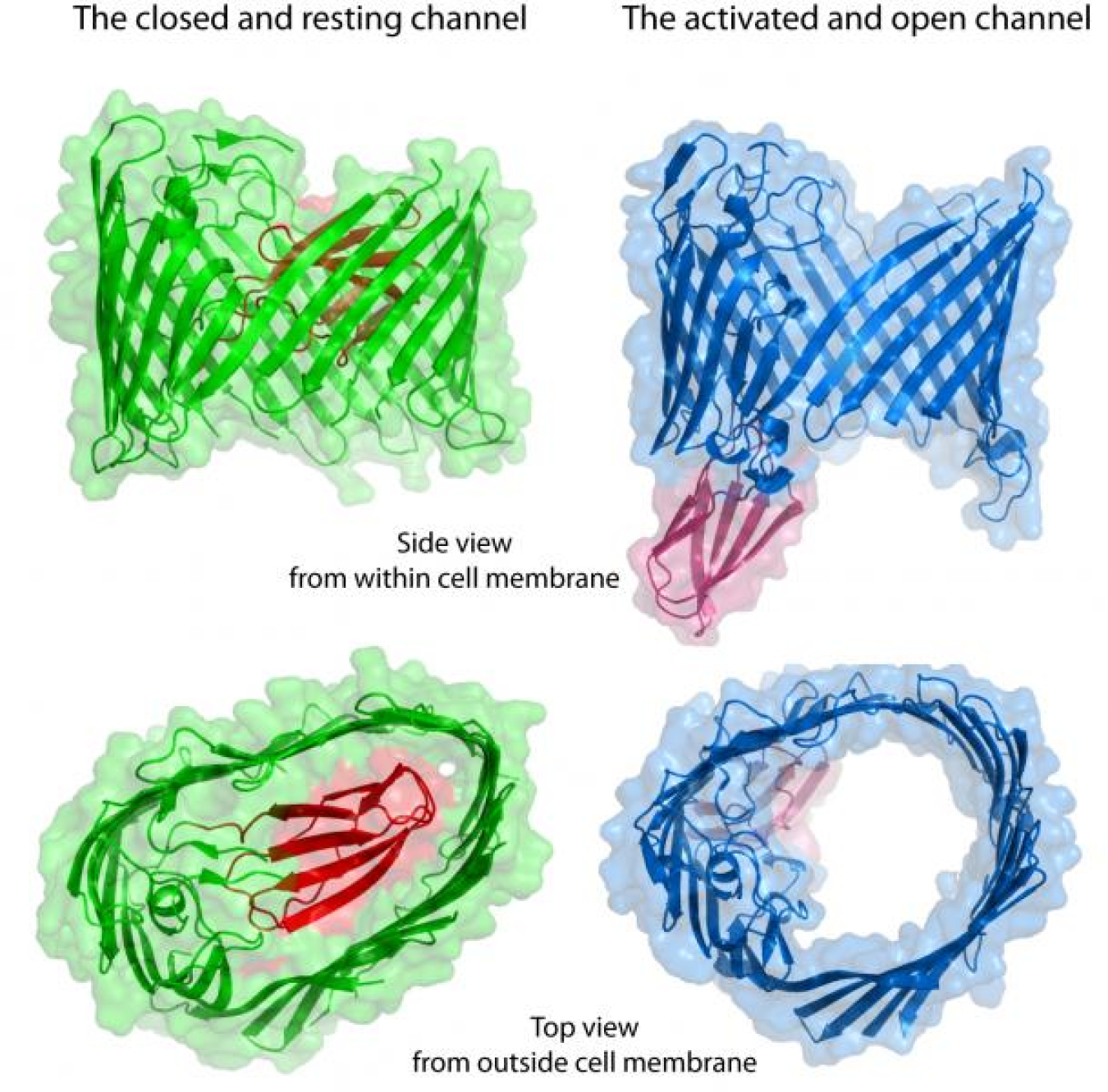Scientists at Brookhaven use the National Synchrotron Light Source (NSLS) to take a look at how the urinary-tract-infection causing strain of E. coli extends its sticky fingers.
June 7, 2011
The bacterial protein transport channel in its resting closed state (green) and the activated open state (blue). The channel is sealed by a plug structure that is shown in red. Note the change of the channel shape from oval to near circular and displacement of the plug when open. Some parts of the protein molecule are omitted for simplicity. | Courtesy of: Brookhaven National Laboratory
What turns an ally into an enemy; an innocuous neighbor into an unfriendly, and even a deadly scourge? That’s what scientists are struggling to understand with the lethal outbreak of the bacteria Escherichia coli (E. coli) currently sweeping across Europe. It’s also what makes recent discoveries by the Department of Energy’s Brookhaven National Laboratory on a different strain of the bacterium -- one which causes urinary tract infections -- all the more important.E. coli is a commonplace bacterium that typically lives a quiet life in the digestive tract of people and animals. But branches of the family (strains of the microbe) sometimes go bad. When they do, they can cause a range of symptoms, ranging from temporary discomfort to urinary tract infections to death, although that is rare.
An infection is somewhat akin to a mugging, in which an unfriendly bacterium gloms onto a healthy cell and causes havoc. That’s true for the strain of E. coli that Brookhaven studied, whose microbes find their way from the gut into the urinary tract, and attach to bladder cells using sticky fingers, or appendages, called pili, to eventually cause infections. The bacterium extends (secretes) its sticky fingers through a complex set of choreography involving a variety of cellular machines called proteins. (For an inexact sense of the intricacy, just consider how many muscles must move in the right sequence simply to extend an index finger.)
So scientists at Brookhaven took a look at how the urinary-tract-infection causing strain of E. coli extends its sticky fingers using the National Synchrotron Light Source (NSLS). Synchrotrons allow scientists to image the position of individual atoms in complex structures, such as proteins, and researchers at Brookhaven -- in concert with their colleagues at the European Synchrotron Radiation Facility -- each captured different aspects of infectious E. coli in the act of secreting its sticky fingers.
Snapshots taken at Brookhaven provide a picture of how E. coli's infectious fingers reach for their quarry (see more photos here), as well as provide researchers with a better sense of how to stop the microbe’s sticky fingers and design drugs that better treat urinary tract infections. A better basic understanding of how E. coli works could lead to additional breakthroughs and ability to control future contagions.
The E. coli snapshots are just one of many research efforts at NSLS. Each year, more than 2,000 scientists use its bright beams to make advances in everything from biology and medicine to physics and materials science. And the NSLS is just one of five synchrotron light sources supported by the Department of Energy’s Office of Science, with a sixth, the NSLS-II, currently under construction.
Amidst outbreaks and other uncertainties, Department of Energy scientists are leveraging the powerful tools of discovery at their fingertips to solve today’s problems and open the way to a brighter, healthier future.
The research was supported by the National Institutes of Health.
For more information on Brookhaven National Laboratory, go to: http://www.bnl.gov/world/. And for more information on the Department of Energy’s Office of Science, please go to: http://www.science.energy.gov/.
More by this author
-
 Senior Public Affairs Specialist and Chief Communicator for Emergency Response and Recovery Efforts
Senior Public Affairs Specialist and Chief Communicator for Emergency Response and Recovery Efforts

